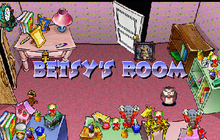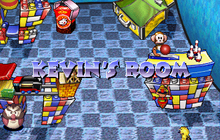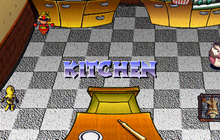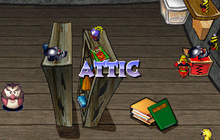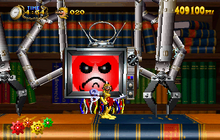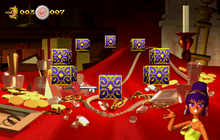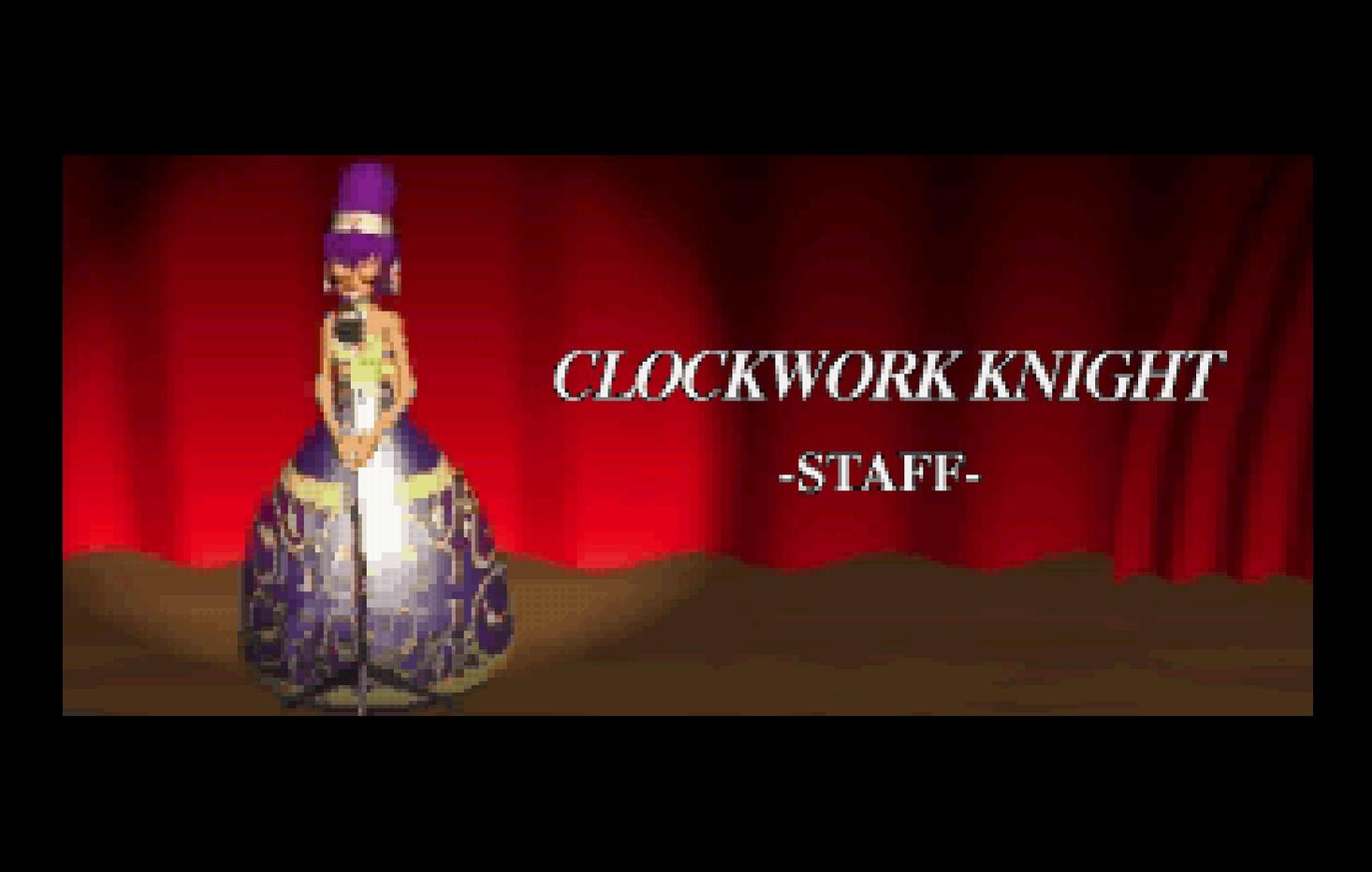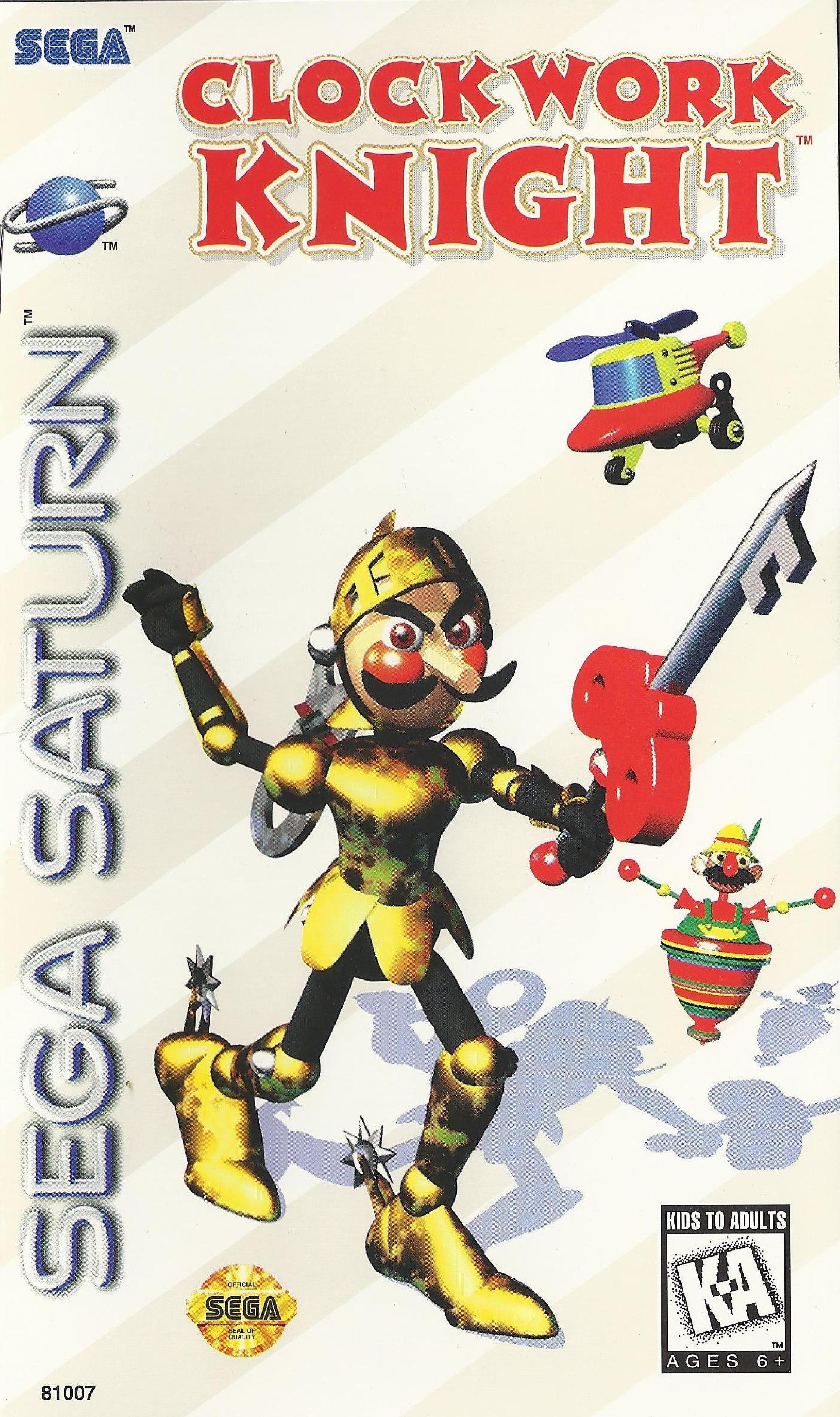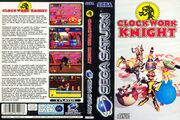Clockwork Knight
From Sega Retro
| Clockwork Knight | |||||||||||||||||||||||||
|---|---|---|---|---|---|---|---|---|---|---|---|---|---|---|---|---|---|---|---|---|---|---|---|---|---|
| System(s): Sega Saturn | |||||||||||||||||||||||||
| Publisher: Sega | |||||||||||||||||||||||||
| Developer: Sega CS | |||||||||||||||||||||||||
| Sound driver: SCSP/CD-DA (2 tracks) | |||||||||||||||||||||||||
| Genre: Action | |||||||||||||||||||||||||
| Number of players: 1 | |||||||||||||||||||||||||
| |||||||||||||||||||||||||
Clockwork Knight, known as Clockwork Knight: Pepperouchau no Daibouken Joukan (クロックワークナイト ペパルーチョの大冒険・上巻) in Japan, is a side-scrolling "2.5D" platform game, released as a launch title for the Sega Saturn in all major territories.
Contents
Story
Sir Tongara de Pepperouchau III ("Pepper" for short) is a toy soldier. He is in love with the Clockwork Fairy Princess, Chelsea, whose voice wakes up the toys of the house every night at midnight. But he is clumsy and something of a laughingstock, especially when compared to his friendly rival Ginger who is also after Chelsea's heart.
One night Chelsea is stolen away by an unknown force, which also hypnotizes some of the lesser toys to become fierce minions and stand in the way of anyone who would try to rescue her. If there's no voice to wake them up anymore then the toys will never live again, so Pepper and Ginger head off to find Chelsea before it's too late.
Characters
- Sir Tongara de Pepperouchau III ("Pepper"): the main protagonist and sole playable character in the main game. He's brave, dashing, and quite clumsy.
- Barobaro: Pepper's nearsighted but ever-faithful donkey-for-a-steed. He appears to be a wine bottle on a wheeled basket. He has a crush on Soltia. Pepper rides on Barobaro's back in a few stages of Clockwork Knight 2, but in this game he only appears in cutscenes.
- Prunchau: Pepper's valet and close friend, this top is also very conscientious of Pepper and sometimes treats him like a little boy. He gives suggestions in the Soltian Roulette.
- Sir Ginger: Pepper's chief rival and something of a showoff, but he works with Pepper in saving Chelsea.
- Silver: Ginger's steed. A horse-shaped clothesbrush, he's quite snobby in thinking he's the perfect horse for the perfect warrior.
- Le Bon: Ginger's valet. Like Prunchau, he also gives suggestions in the Soltian Roulette.
- Sir Oneon de Pepperouchau: Pepper's father. He's a bit overly dramatic; he thinks, for whatever reason, that his family has forsaken him.
- Sir Garluch de Pepperouchau: Pepper's highly-respected, if somewhat misguided, grandfather. He's mysteriously gone missing.
- Pa Zur: Ginger's lord and mentor. All the toys think that the sliding puzzle is a wise old mystic.
- Soltia: A hot-tempered perfume bottle who loves music, cards, and games of chance. She has a crush on Pepper and considers Chelsea to be a rival for his affection. She hosts the Soltian Roulette mini-game that occurs between worlds, also giving suggestions to players like Prunchau and Le Bon do.
- Clockwork Princess Chelsea: This beautiful young doll's voice has the power to wake all the toys every night at midnight. Both Pepper and Ginger compete for her heart. Her kidnapping starts the events of this game and its sequel.
Gameplay
This game is a side-scrolling platformer in the vein of the Mario and Sonic the Hedgehog series. Unlike those games however, the game uses prerendered digitized 2D sprites of high-resolution 3D models similar to the Donkey Kong Country series, or Killer Instinct, on top of fully 3D levels (and with fully 3D bosses).
Pepper attacks enemies with his key. A quick tap of the button (usually ![]() ) will thrust it out horizontally. (He cannot do this vertically.) Likewise, repeatedly tapping the button over and over will cause him to twist the key around and around. This makes it a bit more powerful (e.g.: an enemy could be knocked out temporarily with a simple jab, but running into the key when twisting it will instantly take it out with a pop sound and lots of confetti). In addition to all this, he can also pick up unconscious enemies, or the objects such as footballs or springs that have been scattered around the stages and, toss them (in this case, vertical attacks are possible).
) will thrust it out horizontally. (He cannot do this vertically.) Likewise, repeatedly tapping the button over and over will cause him to twist the key around and around. This makes it a bit more powerful (e.g.: an enemy could be knocked out temporarily with a simple jab, but running into the key when twisting it will instantly take it out with a pop sound and lots of confetti). In addition to all this, he can also pick up unconscious enemies, or the objects such as footballs or springs that have been scattered around the stages and, toss them (in this case, vertical attacks are possible).
The goal is to reach the end of the stage before time or hit points (typically three, though Gold Keys can increase that maximum) run out. There are no checkpoints: dying sends a player back to the beginning of a level. The levels are fairly large (but not as large as the sequel's levels) and contain numerous side areas with treasures.
Every third level of room, Pepper must face off against a large, fully polygonal boss in a one-on-one battle. Each boss has a weakness that must be exploited.
It does not save a player's progress; turning the Saturn off requires the player to start from the beginning next time.
Items
These items lying around for collection:
| Imperial Crowns | |
|---|---|
| Bottle caps with pictures of crowns on them, these are used in the Soltian Roulette mini-game or to earn a game continue. | |
| Pocket Watches | |
| Scattered around almost as much as Imperial Crowns, these award either one or five bonus seconds on the timer. | |
| Keys | |
| These wind-up keys will refill health. They come in three colors; Bronze Keys refill one point, Silver Keys refill all points, and Gold Keys refill all points and increase the maximum by one (this works twice per life, giving up to five hit points total). If Pepper is already at full health with five hit points, the gold key awards an extra life. | |
| Helmets | |
| A blue helmet awards an extra life, and the much-rarer red helmets award three extra lives. | |
| Pa Zur Sphere (Invincible) | |
| This makes Pepper invincible for a short time. |
Levels
This game has thirteen levels, four different rooms with two normal levels and one boss each, plus a final boss. After finishing the boss level of a room 1/2/3, the player can play mini-game with Soltia, Prunchau and Le Bon.
| Betsy's Room (Room 1) | |
|---|---|
| This level is rather linear, making it an easy start for newcomers. Boxes in the background fall onto unsuspecting players. Books slide back and forth in their shelves, threatening to knock Pepper off. Dinosaur bones hang from the ceiling and can hold various goodies for those willing to go up and check them out.
The boss is Dandy Bob, the giant hat-carrying, tuxedo-wearing doll. In the original Japanese version, he has white, human-like skin and blonde hair, while in the NTSC and PAL releases of the game, Dandy Bob is blue-skinned (much like the Edisons from Maniac Mansion) with blue hair. The reason for this change is unknown. | |
| Kevin's Room (Room 2) | |
| Things get tougher here, with numerous battery-powered trains riding tracks over bottomless pits; Pepper had better hop on or else things could get ugly. The floors of the world are often made of LEGO-like blocks, mostly contrasting from the blue background of the stage. Switches can lift various obstacles out of a player's way, or trap them inside if they're not careful. The boss is Double Jetter, a large mech, which can transform into a speedy jet. | |
| Kitchen (Room 3) | |
| Sinks fill with water and drain right back on as Pepper hops from sponge to plate keeping himself from a scalding-hot fate. The metal floors seem to be highly slippery, mimicking the common ice-floor downfalls in many other video games. Watch out for flames from the stoves - pushing some soap and then riding it over them is advised. The boss is Chef de Popot, a chef-shaped squeaky toy with a large pot he carries around, hiding under on the slippery floor. | |
| Attic (Room 4) | |
| Dark, damp and dusty would describe Pepper's final destination (in this trip, at least). Various mazes and platforms that rise and fall are scattered everywhere... Pepper's definitely getting closer to Chelsea and her kidnapper. The boss is Iron Kong X, a monkey-like mech that breaks apart early on, causing its main body to float around, using all but its head as protection by spinning them around at high speeds. | |
| Final Boss | |
| This stage can only be fought when playing it on Normal or Hard. This is the very end of this game - a final one-on-one battle with what appears to be the perpetrator over just who gets Chelsea. But is there a bigger foe at work here? The boss seems to be implying such...the boss is a demented television set named Crazy TV. | |
| Soltian Roulette (Bonus stage) | |
| The player bets Imperial Crowns on the likelihood of getting something from a roulette of various things (ranging from more Imperial Crowns, 1UPs, 3UPs, to Pierron faces, from which the player gains nothing). After betting 5, 10 or 15 Imperial Crowns, the roulette boxes will reveal the contents (the amount of everything varies depending on how much the player bets) then go for a quick spin, after which the player chooses which box the player thinks has what is desired. If the player gets something, it can be kept, or spin again for a double-or-nothing round (this can be done four times, with the amount of doubles going down by one each time). It's certainly not a bad idea to play this, as the later levels can be pretty tricky. |
History
Development

Clockwork Knight is one of Sega's first significant forays into rendering 3D imagery on a computer, being created with Silicon Graphics workstations running Softimage. While the Super NES game Donkey Kong Country is usually credited for being the first big-budget title to take advantage of this technique, Clockwork Knight was just a few weeks behind in Japan.
While it can never be proved, it is likely that Clockwork Knight was inspired by the works of John Lasseter and Pixar, who had been producing groundbreaking computer animated shorts, usually based on normally-inanimate objects, since the mid-1980s. In 1988 Pixar released Tin Toy - a five-minute short featuring senitent toys (which later became a catalyst for Toy Story in 1995). The similar ideas seen in Clockwork Knight beat Toy Story to market by several months (in Japan at least), though was far less of an influence in popular culture. Like Pixar, Sega likely realised that computers of the era was more suited to rendering simple geometric shapes made of plastic or metal, rather than realistic organisms such as animals or humans.
Clockwork Knight was one of the first Sega Saturn games to be announced, being first shown to the public under the working title of "Action Game" at Winter CES 1994. At the time, the Saturn console had not been finalised, and the Clockwork Knight demonstration consisted solely of a jerky, pre-rendered 3D video demonstrating concepts that might appear in the game. The video demonstrates Pepper running, jumping and picking up objects, but also includes a sequence where the character pushes a stack of tins off the edge of a shelf, pushes a floor switch, and fights a jack-in-the-box with a small, red umbrella rather than his "key sword" in the final game.
While only brief, this fight is more involved than anything seen in the final product - Pepper is seen blocking and kicking, as opposed to the enemy exploding when hit once. There is no known accompanying sound to any of the footage, and the world Pepper inhabits is far more subdued than the vibrant kids rooms seen in the final game. This video was included as a bonus in Clockwork Knight: Pepperouchau no Fukubukuro and the US release of Clockwork Knight 2.
Clockwork Knight was intentionally made harder for the US and European markets, because it was believed American consumers preferred tougher games than their Japanese counterparts (and Europeans tougher still)[4].
Legacy
It is not known if the Clockwork Knight story was always meant to span two games, however by releasing the game in Japan as Clockwork Knight: Pepperouchau no Daibouken Joukan ("Joukan" literally translating to "first volume"), a sequel was expected, and arrived the following year as Clockwork Knight 2. Clockwork Knight 2 is often seen as a refined version of the first game - the gameplay remains almost identical and many of the graphics and audio cues were not changed.
The two were later compiled into one release, Clockwork Knight: Pepperouchau no Fukubukuro in Japan, becoming the definitive version of Clockwork Knight.
Versions
Localised names
| Language | Localised Name | English Translation |
|---|---|---|
| English | Clockwork Knight | Clockwork Knight |
| English (US) | Clockwork Knight | Clockwork Knight |
| Japanese | クロックワークナイト ペパルーチョの大冒険・上巻 | Clockwork Knight: Pepperouchau no Daibouken Joukan |
Production credits
- Clockwork Knight -Staff-
- Visual Coordination: Katsuhisa Sato
- Map Construction: Hiroshi Ohba
- Boss Enemies Design: Yusuke Yoshida
- System & Main Character: Yoshio Fukushima
- Background & Visual Effects: Akira Ohe
- Enemies & Traps: Takashi Amami, Toshihiro Kumazaki (Hitachi Microsoftware Systems,Inc.)
- Boss Enemies & Traps: Shinya Tsukizaki, Hiroaki Sakamoto, Tetsu Katano
- World Map & Goal: Hiroshi Momota
- Opening & Ending: Yoshio Inoue
- Bonus Game: Yuichi Matsuoka
- Main Characters: Toshiyuki Mukaiyama, Ryuichiroh Kutsuzawa
- Front Stage: Namie Manabe, Takehiko Miura, Yoshihito Takahashi
- Background: Shiroh Kinemura, Masahiro Sanpei, Osamu Ogata, Yumiko Miyabe
- Opening & Ending: Norihiro Nishiyama
- Graphical Supervision: Masayuki Hasegawa
- Direction & Music Compose: Hirofumi Murasaki
- Sound Effects: Seiroh Okamoto, Katsuyoshi Nitta
- Sound Program: Kazuya Fujishima, Naomi Yamamoto, Ken-ichiroh Ohkuma
- Sega Sound Library by: InVision Interactive
- Sega Digital Studio
- Recording Producer: Tatsutoshi Narita
- Recording Director: Fumitaka Shibata
- Recording Engineer: Naoyuki Machida
- Product Manager: Tomoaki Ogawa, Kazuhiro Hanaya
- Promotion: Tadashi Takezaki
- Director: Tomoyuki Itoh
- Producer: Noriyoshi Ohba
- Producers: Yoji Ishii, Makoto Oshitani
- Executive Producer: Mamoru Shigeta
- Special Thanks: Triad Project (Toru Sasaki, Tsutomu Kataoka, Asami Sasaki), Shinji Kawahira, Yousuke Okunari, Tomoko Hasegawa
- Opening Theme: "Clockwork Knight"
- Vocals: Misumi Kosaka, Shiori Fujita
- Words: Reiko Waters
- Music: Hirofumi Murasaki
- Arranged: Tomoko Tsuyama
- Manipulated: Nobuo Itoh
- Main Theme: "A Lullaby"
- Vocals: Misumi Kosaka
- Words: Reiko Waters
- Music: Hirofumi Murasaki
- Arranged: Tomoko Tsuyama
- Manipulated: Nobuo Itoh
- Presented by: Sega Enterprises,Ltd. 1994
- Product Development:
- Producer: Dante Anderson
- Lead Tester: Kim Rogers
- English Text: Kerry Kirkham
- Assistant Leads: Jeff Loney, Crisi Albertson, Mike Williams
- Testers: Caroline Trujillo, Lance Nelson, Jeff Junio, Fernando Valderrama, Kerry Kirkham, Morgan Weiss, Sancho Martinez, Sean McInnes, Arnold Feener, Mark Griffen
- Marketing:
- Product Manager: Sarah Mason Richmond
- Product Specialist: Nemer Velasquez
- Manual: Marc Sherrod
- Special Thanks: James Spahn, Sutton Trout, Lorene Goble
Soundtrack
A soundtrack album, Clockwork Knight: Pepperouchau no Daibouken Fantastic Soundtrack, was released exclusively in Japan two days before the Japanese release of the second game.
Magazine articles
- Main article: Clockwork Knight/Magazine articles.
Physical scans
| 74 | |
|---|---|
| Based on 50 reviews | |
| Saturn, BR |
|---|
| <div style="margin:auto; max-width:Expression error: Unexpected < operator.px">
320x120px Cover
|
Technical information
ROM dump status
| System | Hash | Size | Build Date | Source | Comments | |||||||||
|---|---|---|---|---|---|---|---|---|---|---|---|---|---|---|
| ✔ |
|
247,696,176 | CD-ROM(EU) | MK81007-50 V1.000 | ||||||||||
| ✔ |
|
247,830,240 | 1994-11-15 | CD-ROM(JP) | GS-9004 V1.000 | |||||||||
| ? |
|
247,698,528 | CD-ROM(US) | 81007 V1.002 |
Track list
| 1. [data track] |
|---|
| 2. Clockwork Kinght (Opening demo 1) (00:46) |
|---|
| 3. Clockwork Kinght (Opening demo 2) (02:09) |
|---|
External links
- Sega of Japan catalogue page (Japanese): Sega Saturn
References
- ↑ Press release: 1995-05-19: Sega Saturn launch takes consumers and retailers by storm
- ↑ 2.0 2.1 2.2 GamePro, "August 1995" (US; 1995-xx-xx), page 54
- ↑ 3.0 3.1 3.2 Mean Machines Sega, "October 1995" (UK; 1995-08-25), page 90
- ↑ GamePro, "January 1996" (US; 199x-xx-xx), page 49
- ↑ File:Clockworkknight_Saturn_JP_SSEnding.pdf
- ↑ File:Clockworkknight sat us manual.pdf, page 22
- ↑ 7.0 7.1 CD Consoles, "Février 1995" (FR; 1995-xx-xx), page 120
- ↑ 8.0 8.1 Consoles +, "Février 1995" (FR; 1995-0x-xx), page 118
- ↑ Consoles +, "Septembre 1995" (FR; 1995-0x-xx), page 136
- ↑ 10.0 10.1 Computer & Video Games, "February 1995" (UK; 1995-01-15), page 28
- ↑ 11.0 11.1 Edge, "March 1995" (UK; 1995-01-26), page 72
- ↑ 12.0 12.1 GameFan, "Volume 3, Issue 7: July 1995" (US; 1995-xx-xx), page 13
- ↑ GamePro, "April 1995" (US; 1995-xx-xx), page 150
- ↑ 14.0 14.1 Joypad, "Décembre 1994" (FR; 1994-1x-xx), page 162
- ↑ 15.0 15.1 Joypad, "Septembre 1995" (FR; 1995-0x-xx), page 70
- ↑ 16.0 16.1 Maximum, "October 1995" (UK; 1995-09-01), page 145
- ↑ 17.0 17.1 Mean Machines Sega, "February 1995" (UK; 1994-12-30), page 84
- ↑ 18.0 18.1 Next Generation, "April 1995" (US; 1995-03-21), page 89
- ↑ 19.0 19.1 Player One, "Juillet/Août 1995" (FR; 1995-0x-xx), page 64
- ↑ 20.0 20.1 Sega Saturn Magazine (readers), "Final data" (JP; 2000-03), page 14 Cite error: Invalid
<ref>tag; name ":File:SnGwSISDRZK Book JP.pdf_p14" defined multiple times with different content - ↑ 21.0 21.1 Ultimate Future Games, "March 1995" (UK; 1995-02-03), page 82
- ↑ 22.0 22.1 File:UltimateGamer US 01.pdf, page 89 Cite error: Invalid
<ref>tag; name ":File:UltimateGamer US 01.pdf_p89" defined multiple times with different content - ↑ Última Generación, "Abril 1995" (ES; 1995-0x-xx), page 81
- ↑ 1700 igr dlya Sega, "" (RU; 2001-xx-xx), page 48
- ↑ Alaab Alcomputtar, "" (SA; 1995-08-xx), page 74
- ↑ Digitiser (UK) (1995-07-11)
- ↑ Electronic Entertainment, "August 1995" (US; 1995-0x-xx), page 77
- ↑ Electronic Gaming Monthly, "July 1995" (US; 1995-0x-xx), page 38
- ↑ Excalibur, "" (CZ; 1995-08-01), page 1
- ↑ Famitsu, "1994-12-30" (JP; 1994-12-16), page 1
- ↑ Game Players, "Vol. 8 No. 8 August 1995" (US; 1995-0x-xx), page 36
- ↑ GamePro, "April 1995" (US; 1995-xx-xx), page 144
- ↑ Games World: The Magazine, "September 1995" (UK; 1995-0x-xx), page 69
- ↑ Hobby Consolas, "Agosto 1995" (ES; 1995-xx-xx), page 98
- ↑ LeveL, "Červen 1995" (CZ; 1995-06-01), page 36
- ↑ MAN!AC, "02/95" (DE; 1995-01-11), page 26
- ↑ MAN!AC, "08/95" (DE; 1995-07-12), page 46
- ↑ Mega, "April 1995" (UK; 1995-03-30), page 18
- ↑ Mega Force, "Janvier 1995" (FR; 199x-xx-xx), page 52
- ↑ Mega Fun, "08/95" (DE; 1995-07-19), page 83
- ↑ Power Unlimited, "Jaagang 3, Jul/Aug 1995" (NL; 1995-06-28), page 38
- ↑ Saturn Fan, "1995 March" (JP; 1995-02-08), page 40
- ↑ Saturn+, "Christmas 1995" (UK; 1995-12-14), page 56
- ↑ Score, "Květen 1995" (CZ; 1995-05-01), page 30
- ↑ Sega Magazin, "August 1995" (DE; 1995-07-12), page 65
- ↑ Sega Magazine, "August 1995" (UK; 1995-07-13), page 60
- ↑ Sega Power, "April 1995" (UK; 1995-02-16), page 63
- ↑ Sega Pro, "March 1995" (UK; 1995-01-26), page 34
- ↑ Sega Pro, "September 1995" (UK; 1995-08-10), page 50
- ↑ Sega Megazone, "August 1995" (AU; 1995-0x-xx), page 24
- ↑ Super Juegos, "Agosto 1995" (ES; 1995-0x-xx), page 82
- ↑ Todo Sega, "Septiembre 1995" (ES; 1995-0x-xx), page 36
- ↑ Tricks 16 bit, "Tricks Sega Gold 800 igr" (RU; 1998-03-20), page 44
- ↑ Ultimate Future Games, "September 1995" (UK; 1995-08-01), page 89
- ↑ Última Generación, "Abril 1995" (ES; 1995-0x-xx), page 78
- ↑ Video Games, "8/95" (DE; 1995-07-26), page 67
- ↑ VideoGames, "June 1995" (US; 1995-0x-xx), page 72
| Clockwork Knight | |
|---|---|
|
Main page | Comparisons | Credits | Hidden content | Magazine articles | Video coverage | Reception | Technical information
Music: Clockwork Knight: Pepperouchau no Daibouken Fantastic Soundtrack (1995)
Demos: Clockwork Knight Sample (1994)
Prototypes: 1995-02-06
| |
| Clockwork Knight series of games | |
|---|---|
| Clockwork Knight (1994) | Clockwork Knight 2 (1995) | Clockwork Knight: Pepperouchau no Fukubukuro (1995) | Clockwork Knight: Pengin War (Cancelled) | |
| Knight'n Knight (Cancelled) | |
| Sampler Discs | |
| Clockwork Knight Sample (1994) | Prime Selection Vol. 1 (1995) | |
| Clockwork Knight related media | |
| Clockwork Knight: Pepperouchau no Daibouken Fantastic Soundtrack (1995) | Israelites (1996) | |
| Clockwork Knight: Pepperouchau no Daibouken (1994) | Clockwork Knight: Pepperouchau no Daibouken Joukan Koushiki Guide Book (1995) | Clockwork Knight: Pepperouchau no Daibouken Gekan Koushiki Guide Book (1995) | |
- Pages with reference errors
- 1 player games
- JP Saturn games
- All JP games
- US Saturn games
- All US games
- EU Saturn games
- All EU games
- BR Saturn games
- All BR games
- Saturn games
- 1994 Saturn games
- All 1994 games
- Saturn action games
- All action games
- Old content rating field
- All games
- Bad translation
- Old-style rating (cdconsoles)
- Old-style rating (consolesplus)
- Old-style rating (cvg)
- Old-style rating (edge)
- Old-style rating (ee)
- Rating without PDF source
- Old-style rating (egm)
- Old-style rating (excalibur)
- Old-style rating (famitsu)
- Old-style rating (famitsu r)
- Old-style rating (gamefan)
- Rating without source
- Old-style rating (gamepro)
- Old-style rating (gameplayers)
- Old-style rating (gamesworld)
- Old-style rating (hobbyconsolas)
- Old-style rating (joypad)
- Old-style rating (maniac)
- Old-style rating (maximum)
- Old-style rating (mms)
- Old-style rating (nextgeneration)
- Old-style rating (playerone)
- Old-style rating (pu)
- Old-style rating (segapower)
- Old-style rating (segapro)
- Old-style rating (ssmjp r)
- Old-style rating (ufg)
- Old-style rating (ug)
- Use magref
- Old-style rating (ultimageneracion)
- Old-style rating (vgce)
- Update ratings template
- 34 old ratings
- Pages with broken file links
- Missing ROM hashes
- Old technical information
- Track missing credits
- Clockwork Knight
- Clockwork Knight (franchise)

